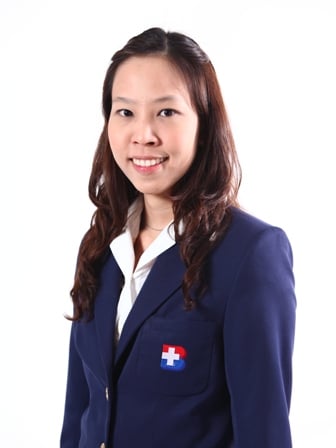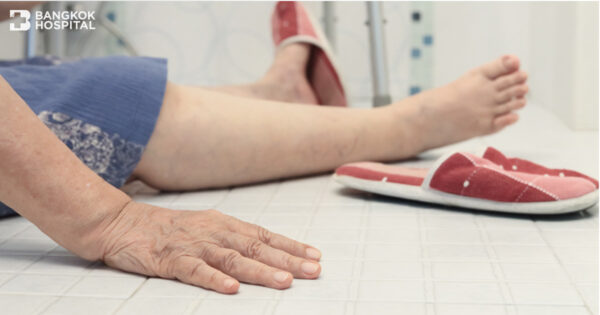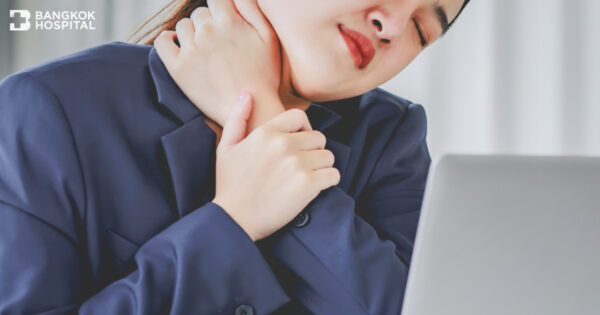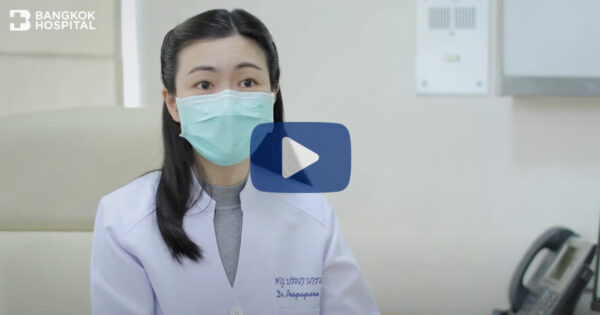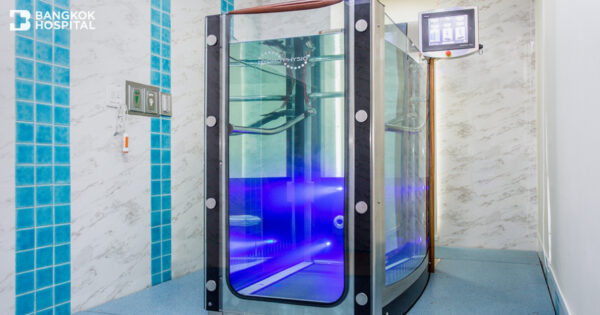Today, there are up to 1,600 fatalities from accidental falls in Thailand. It is the second leading cause of unintentional deaths, following road accidents. Of the total cases, 1 in 3 were people over 60 years old; and the risk increases with age. The most common problems from these falls were hip fracture and brain injury that result in high numbers of disabilities and also deaths. Fortunately, the risk of an accidental fall can be mitigated by family members’ close attention.
Accidents in the Elderly
These are caused by degenerative conditions related to ageing. In addition, there are diseases that also affect the function of various organs. The most common accident in the elderly is falling – such as slipping in the bathroom, falling from the bed, falling down the stairs, etc. It usually happens to people between the ages of 65-75. The most injuries include hip fracture which can cause disability and, consequently, lead to the high number of deaths. This is due to their osteoporosis conditions, and the fall can only amplify it. Even though a surgery may have taken care of the initial break, a senior still has to be careful to prevent another accident that may cause repeated fractures.
Symptoms of suspected hip fracture include aches and pain around the area of injury, and unable to get up or put weight on the leg with the broken hip. If you believe a senior under your care has a hip fracture, get him/her to remain in a comfortable position with as little movements as possible. Then, call an ambulance immediately.
Another problem resulting from a fall in the elderly is head injury. This increases the risk of a brain hemorrhage, and the symptoms may not be related to how hard they fall either. In any case, if they have a head injury, they need to be seen by a doctor promptly for evaluation that may also include a CT scan and hospitalization for observation as needed.
Causes of a Fall
A fall can be prevented, but you need to know the root cause which includes:
- Physical condition such as poor balance, weak muscles, numbness, fatigue, dizziness, vision and hearing problems, side effects of medication that impact blood circulation and osteoporosis.
- Environmental factors such as slippery and wet floor, uneven floor, poor lighting, unstable or damage equipment, improper walking aids, unsuitable clothes or shoes.
How to Provide First Aid and Basic Care for the Elderly After A Fall
Patients with a head injury and concussion should be left lying down and require emergency medical attention immediately.
- Patients without concussion but have a neck pain should lie down flat on their backs without pillow support while someone calls for an ambulance promptly. Try to keep the patients’ movements to a minimum.
- Patients with hip or thigh pain should lie down in a comfortable position. Do not move them as this may cause more fractures. Let the emergency service crew take care of them.
- For patients who bump their heads but have no neck pain and still remain conscious, their relatives should take them to the hospital.
- For patients who are bleeding, apply firm and steady pressure directly over the wound with pieces of clean cloth for 10 – 15 minutes.
Each year, every 1 in 3 seniors experiences multiple falls. 10% of those are caused by slippery surfaces and result in hip fractures, while 25% are related to hip fractures that also lead to fatalities. Slip and fall often occur in residential areas, especially in bathrooms and staircases. It is found that 80% of the patients who have a fracture for the first time have never been examined or treated for osteoporosis previously. Moreover, an elderly who has fallen once will face 2-3 times greater risk of more falls in the future.
Furthermore, almost 100% of the elderly who have fractures from a fall also have some congenital diseases – such as high blood pressure, diabetes, high cholesterol, heart disease, and chronic kidney failure. Therefore, caring for them is very complex; and when they are at the hospital, they may face other risks – such as bed sore, pneumonia, and various infections, etc.
How To Prevent an Accidental Fall
Guidelines for fall prevention
Promote wellness for the elderly – such as walking, weight training and practicing ankle mobility.
- Use of a walking aid – such as walker or cane.
- Lifestyle modification – such as getting up slowly and looking around for a sturdy support in case of emergency.
- Do not walk into wet areas.
- Home safety for older adults, especially for fall patients who risk repeated falls and need preventive measures:
-
- Install lighting in the walkway.
- Bed, chair and toilet should have of suitable heights.
- Choose slip-resistant flooring.
- Railings around all steps
- Use a flushing toilet.
- Put a chair in the shower and changing areas.
- Items should be placed in an easy-to-reach area at the elbow level.
- Items in the bedroom and living room should be kept tidy and easy to find.
- No obstruction on the floor, especially messy wiring.
- Ensure sufficient lighting, especially in the walkway to the bathroom.
- Keep bedroom and bathroom floors free from obstruction.
- Keep walkway dry.
- Move and get up from bed slowly.
- Kitchen items should be arranged within easy reach.
- Store heavy objects in lower storage.
- Do not polish the floors.
- Avoid using stairs. If necessary, make sure there is a sturdy rail and the steps are wide. Climb up or down slowly.
-
Accident Risk Assessment
Family members should assess risk of an accident such as
Observe any symptoms and abnormality in their visions.
- Observe their balance and any problem while they are walking. In senior adults, their sensory abilities decline. This results in impairments in their balance.
- Observe any deterioration in their cognitive abilities – such as confusion, forgetting about dates, time, places or people – as well as their perception, decision making ability, or slow reactions.
- Review and consult the doctor about medications that may increase the risk of a fall.
- Consistently assess the conditions of the dwellings, both inside and outside around the house.
Aside from the family’s initial risk assessment, Rehabilitation Center at Bangkok Hospital also has technology and tools to help evaluate fall risks in the elderly which range from strength, flexibility, balance, movements and cognitive abilities:
- Strength: Trendelenberg test
- Flexibility: Sit and Reach test
- Cognition: Vienna test
- Movement: Time up and Go test (TUG)
- Balance: Balance Master (Keith’s protocol)
The evaluation will be conducted by an experienced specialist who will interpret the results according to an established international standard. The final outcome will be used as a guideline for training and exercises to prevent a fall. It is built around the Otago exercise program, which is based on key physical risk factors for a fall – such as muscles strength, flexibility, balance and ability to react quickly. This program is easy to follow and can prevent as well as reduce the rate of accidental falls in the elderly. Even people over 90 years of age can effectively improve their strength and body balance to avoid a fall after the training.
However, family members should keep an eye on their elders. If there is an accident, they should be taken to the hospital for examination in case there are broken bones – especially broken hip bones – or head injuries; as these can be fatal. Do not assume that the reason your elders cannot walk is due to physical deterioration or congenital diseases such as dementia and depression. At Bangkok International Hospital, we have a team of doctors specializing in hip fractures; and have, in addition, established a high standard of treatment specifically for hip fractures in seniors. Our teams of multidisciplinary specialists for hip fractures include geriatricians, physiatrists, dieticians, and physical therapists. Before the surgery, patients will have preoperative evaluation and physical readiness assessment – such as acute confusion, ability to move and perform daily routines, and ability to prevent a fall, etc. Our patients generally will undergo the surgery within 36 hours, as studies have shown that the sooner the operation, the faster the recovery and with less complications.
Healthy Tips for the Elderly
How to Take Care of the Elderly
Get enough nutrition by focusing on vegetables and fruits to keep the body in tune and to prevent diseases.
- Abstain from food that can cause fatigue and dizziness.
- Ambulate everyday – such as walking or age-appropriated exercises (e.g., Tai-chi) – to keep the body’s balance and flexibility. Join an exercise program.
- Check eyesight and hearing regularly. If there is a problem, get vision and hearing aids.
- Inquire about side effects of prescribed medications – such as medicine that causes drowsiness, sedative, blood pressure medicine, and diuretics – or if you are taking 4 or more drugs (excluding vitamins). If the medicines make you sleepy or lethargic or drowsy, you need to change your daily routine to reduce the risk of a fall. Do not mix medicine with alcohol.
- Do not drink alcohol because it is the cause of a fall.
- Use walking aids. Check your walking aids if they are of suitable height and sturdy. They should also have rubber tips. When slipping and falling, try to land on a thick or soft surface. After the fall, do not try to get up immediately. Check, first, if you are hurt. Do not be afraid that you might fall again. Analyze how it happened and find a remedy.

